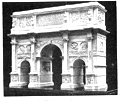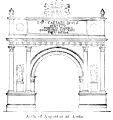Arcus Triumphālis
A triumphal arch. These arches were peculiar to the Romans, and were usually detached
structures built across the principal streets of the city, and, according to the space of
their respective localities, consisted of either a single archway, or of a central one for
carriages, with two smaller ones on each side for foot-passengers, which sometimes had side
communications with the central arch. Sometimes there were two arches of equal height, side by
side. Each front was ornamented with trophies and bas-reliefs, which were also placed on the
sides of the passages. Both façades had usually columns against the piers,
supporting an entablature, surmounted by a lofty attica, on the front of which was the
inscription, and on the top of it bronze chariots, war-horses, statues, and trophies. The
triumphal arch recalls its original, the city gate, in the concentration of ornament on the
façades, while the sides, which in the city gate are buried in the wall, are
comparatively plain.
Stertinius is the first upon record who erected anything of the kind. He built an arch in
the Forum Boarium, about B.C. 196, and another in the Circus Maximus, each of which was
surmounted by gilt statues. Six years afterwards, Scipio Africanus built another on the Clivus
Capitolinus, on which he placed seven gilt statues and two figures of horses; and in B.C. 121,
Fabius Maximus built a fourth in the Via Sacra, which is called by Cicero the Fornix Fabianus.
None of these remain, the Arch of Augustus at Rimini being one of the earliest among those
still standing.
There are twenty-one arches recorded by different writers as having been erected in the city
of Rome, five of which still remain:
1.
Arcus Drusi, which was erected to the honour of Claudius Drusus
on the Appian Way.
2.
Arcus Titi, at the foot of the Palatine, which was erected to the
honour of Titus after his conquest of Iudaea, but does not appear to have been finished till
after his death, since in the inscription upon it he is called
Divus, and is
also represented as being carried up to heaven upon an eagle. The bas-reliefs
 |
|
Arch of Constantine at Rome.
|
of this arch represent the spoils from the Temple of Jerusalem carried in triumphal
procession. This arch has only a single opening, with two columns of the Roman or Composite
order on each side of it.
3.
Arcus Septĭmi Sevēri, which was erected by
the Senate (A.D. 207) at the end of the Via Sacra, in honour of that emperor and his two
sons, Caracalla and Geta, on account of his
 |
|
Arch of Septimius Severus.
|
conquest of the Parthians and Arabians.
4.
Arcus Galliēni, erected to the honour of Gallienus by a
private individual, M. Aurelius Victor.
5.
Arcus Constantīni, which is larger and more profusely
ornamented than the Arch of Titus. It has three arches in each front, with columns similarly
disposed, and statues on the entablatures over them, which, with the other sculptured ornaments, originally decorated the Arch of Trajan.
 |
|
Arch of Augustus at Aosta.
|
See Burn,
Rome and the Campagna; Middleton,
Ancient Rome in
1885; id.
Remains of Ancient Rome 1892); and the article
Architectura.







